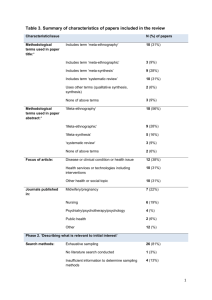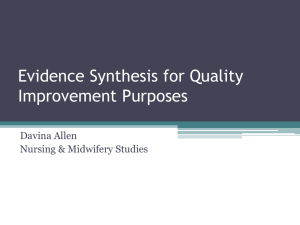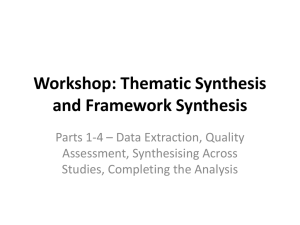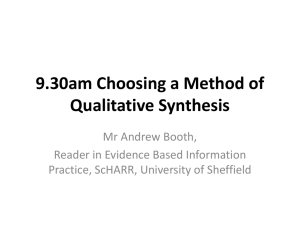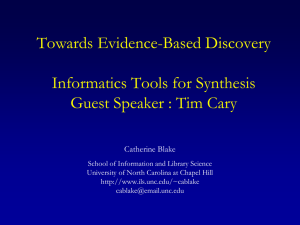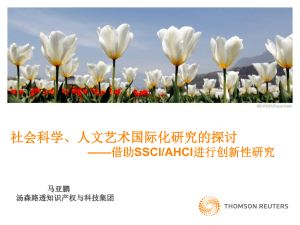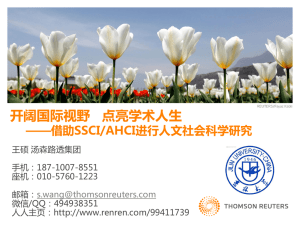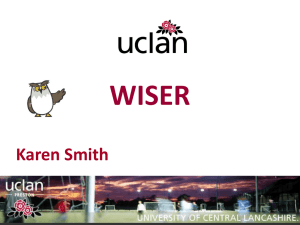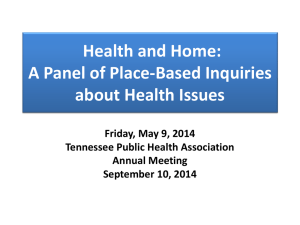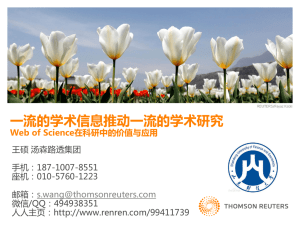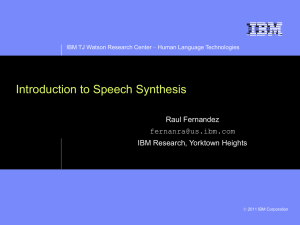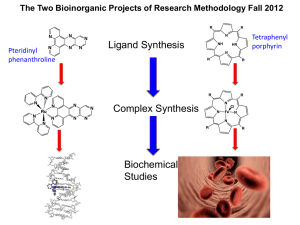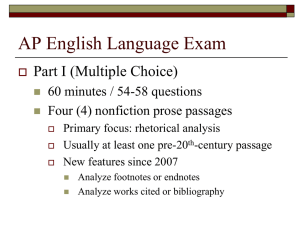Framework Synthesis, Meta-Ethnography and Realist
advertisement
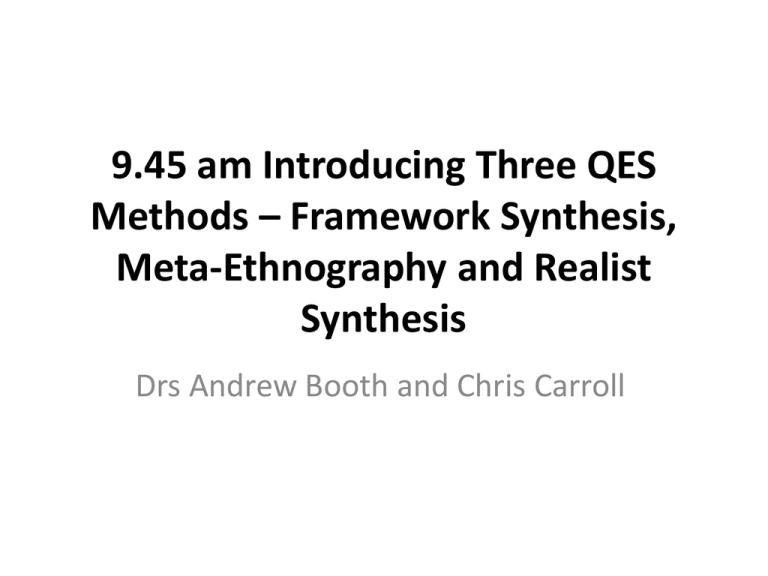
9.45 am Introducing Three QES Methods – Framework Synthesis, Meta-Ethnography and Realist Synthesis Drs Andrew Booth and Chris Carroll Framework for systematic reviews of qualitative research (Garside, 2010) Stage Typical activities Developing research question Assemble team; Consult; Agree approach Scoping exercise Identify relevant research; Refine methods Identifying relevant literature Develop Inclusion/Exclusion criteria; Focused searches; Citation searches Initial assessment of study reports Preliminary reading; Identify theories; Assess utility/relevance Analysis and synthesis Reading & rereading study reports; Constant comparison; Assess validity Preliminary synthesis Categorising; tabulating; mindmaps; Explore relationships Full synthesis Thematic analysis; translation of findings; Theory development; rival explanations Dissemination Target audiences; Limitations of review Throughout Multiple viewpoints; Reflexivity; Audit trail; Ongoing consultation; revisit review purpose Three QES Methods…….. Best Fit Framework Synthesis A Framework How do you create a framework? Develop own framework or themes or concepts for coding Oliver S et al: A multidimensional conceptual framework for analysing public involvement in health services research. Health Expectations 2008, 11:72-84. Brunton G, Oliver S, Oliver K, Lorenc T. A Synthesis of Research Addressing Children’s, Young People’s and Parents’ Views of Walking and Cycling for Transport London. London, EPPI-Centre, Social Science Research Unit, Institute of Education, University of London; 2006. Identify or create a thematic framework or conceptual model Carroll C, Booth A, Cooper K. A worked example of “best-fit” framework synthesis: A systematic review of views concerning the taking of potential chemopreventive agents, BMC Medical Research Methodology 2011; 11: 29 An existing conceptual framework Conrad K, et al (1996). The worksite environment as a cue to smoking reduction. Research in Nursing & Health, 19 21-31. A Framework Thematic synthesis Framework synthesis Meta-Ethnography Meta-Ethnography • Why look at meta-ethnography? – Most common and longest established QES method – Hannes K, Macaitis K. A move to more systematic and transparent approaches in qualitative evidence synthesis: update on a review of published papers, Qualitative Research, 2012; 12: 402-442. • What do we mean by meta-ethnography? • How do you complete the stages of metaethnography? Meta-ethnography “... involves taking relevant empirical studies to be synthesised, reading them repeatedly and noting down key concepts (interpretive metaphors). These key concepts are the raw data for the synthesis. Noblit and Hare suggested that the process by which a synthesis is achieved is one of translation. This entails examining the key concepts in relation to others in the original study and across studies ... The purpose of the translation is to try to derive concepts that can encompass more than one of the studies being synthesised. The synthesised concepts may not have been explicitly identified in any of the original empirical studies” 1. 2. Campbell R et al. Evaluating meta-ethnography: systematic analysis and synthesis of qualitative research, HTA 2011; 15: 43 Noblit GW, Hare RD. Meta-Ethnography: Synthesising Qualitative Studies. Newbury Park (CA): Sage Publications, 1988 Conducting a meta-ethnography (Atkins et al 2008) Step 1: Getting started Step 2: Deciding what is relevant to the initial interest Step 3: Reading the studies Step 4: Determining how studies are related Step 5: Translating studies into one another Step 6: Synthesising translations Step 7: Expressing the synthesis Meta-ethnography: 7 phases Phase 1: Getting started Phase 2: Describing what is relevant to initial interest Phase 3: Reading the studies – repeated reading and noting of concepts or metaphors Phase 4: Determining how studies are related – task of creating a list of key metaphors, phrases, ideas or concepts (and their relations) used in each account, and juxtaposing them. Leads to initial assumptions about relations between studies, e.g. Are they related? Are they answering the same question, considering the same problem, from the same perspective? Meta-ethnography: 7 phases Phase 5: Translating the studies into one another – the metaphors and/or concepts in each account and their interactions are compared with the metaphors and/or concepts and their interactions in other accounts. First level of meta-ethnographic synthesis. Phase 6: Synthesizing translations – unique metaphors/concepts or one able to encompass those of other accounts, which are able to produce a new interpretation/conceptual development. Phase 7: Expressing the synthesis – communication of findings that takes account of the intended audience’s own culture and its concepts and language. Realist Synthesis In a nutshell, realist synthesis… • Configures beginning theory to explain “what works for whom in what circumstances and in what respects” (Pawson, 2006, p.74) • Configures Contexts, Mechanisms and Outcomes (CMO configurations) • E.g. Hospital league tables cp. School league tables, Surgeon performance tables [Mechanisms?] CMO Configurations Example CMO Configurations Example CMO Configurations QUANTITATIVE e.g. Different effect sizes change on motivation scale QUALITATIVE e.g. Explanations for employee motivation “We had low morale because…” Realist synthesis can • Discover weak links in an “implementation chain” (critical success factors) • Adjudicate between rival theories • Identify contextual factors leading to improved or impaired effectiveness • Compare anticipated performance with actual performance Steps in a realist synthesis – Iterative! Identify review questions Search for primary studies Extract data & appraise evidence Synthesise findings Sounds easy doesn’t it? Now select you preferred workshop choices (1st and 2nd) A.Best Fit Framework Synthesis B. Meta-Ethnography C. Realist Synthesis And to Coffee Break……..
